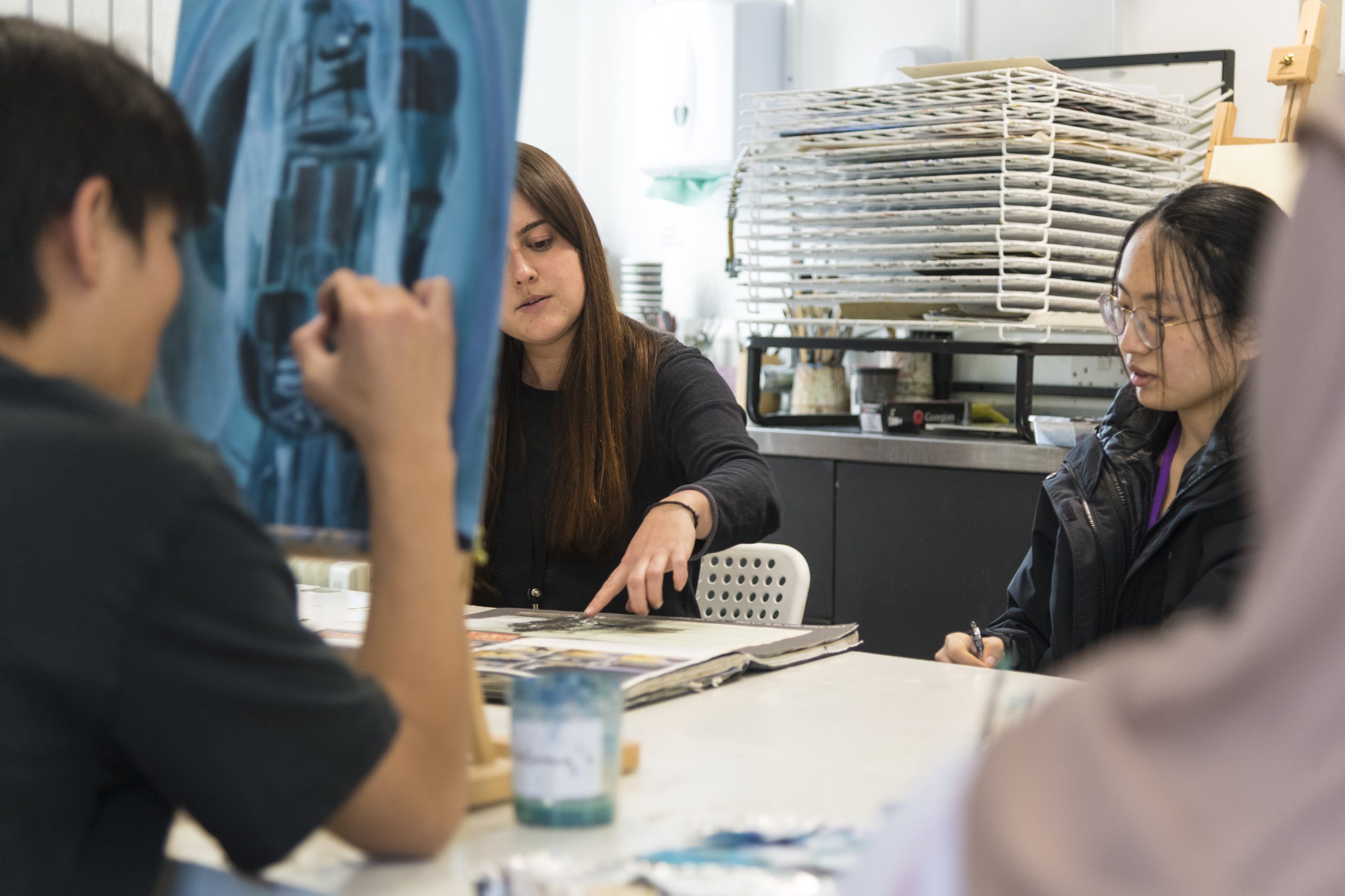For my CamSTAR Research project, I will be looking at how we can make visible (explicit) the invisible (implicit)cultural boundaries impacting the effectiveness of feedback.
David Didau makes us aware of the input/output myth “what we teach is what students learn”. (Didau, D. 2013). When we give feedback, we expect students to receive this feedback in the way that we intended. However, when we give feedback in an international classroom setting, ‘both intended and received meanings of messages pass through cultural filters (…) and the greater the differences are between two cultural filters, the greater are the opportunities for misunderstanding the occur.’ (Tian, M. 2013).
“As teachers, [cultural filters are] particularly important for us to appreciate. While we may feel that we are being balanced and clear in our feedback, students may just focus on the positive or negative aspects of what we say or dismiss it as entirely inconsequential depending on their own prior experiences”
– Rob Mathers (Head of Mathematics)
At CATS Cambridge, we have adopted a novel approach – that of a Reading Group, using the World Café Method. The World Café Reading Group (WCRG) meets each half term to discuss a wide range of books, articles, and other sources. We apply these concepts to our educational context, teaching practice, and learning community. We recognise that teacher learning is the key to student learning, and through the WCRG we keep up to date with recent, relevant, and global discussions on topics that matter to us and our students.
In the Autumn term, inspired by Shaun Tan’s wordless book ‘The Arrival’ I developed an art project to address different ways of belonging and what belonging means to our students. They expressed their insights visually using pencils, charcoal, photography, and printmaking. Other WCRG topics and books include Jordan Peterson’s debate on modernism and the gender pay gap; Reni Eddo’s book: ‘Why I No Longer Talk to White People About Race’; ‘The Wellness Syndrome’ by Carl Cederstrom & Andre Spicer, and Deborah Fellow’s ‘Dreaming in Chinese’.
On 30th September 2021, we held our first World Café Reading Group of this academic year. The book we discussed was ‘The Culture Map’ by Erin Meyer. Meyer provides a field-tested model for decoding how cultural differences impact international business. She highlights eight dimensions and by analysing the positioning of one culture relative to another, on each of the eight dimensions, we can decode how culture influences day-to-day international collaboration.
“Today, many people are part of global networks connected with people scattered around the world. Yet, we often have little understanding of how local culture impacts global communication. Even those who are culturally informed, travel extensively and have lived abroad often have few strategies for dealing with cross-cultural misunderstandings.” (Meyer, E. 2015)
‘Often it is argued that speaking of cultural differences leads us to stereotype and therefore put individuals in boxes with ‘general traits’ and that instead of talking about culture, it is important to judge people as individuals, not just as produces of their environment.’ (Shah, R. 2014). However, Erin Meyer explains: ‘if you go into every interaction assuming that culture does not matter, your default mechanism will be to view others through your own cultural lens and to judge/misjudge them accordingly.’ (Meyer, E. 2016). Let’s look at cultural miss-communication first.
HIGH- AND LOW CONTEXT CULTURES
One way to understand cultural miss-communication, is to examine low-context and high-context cultures. The difference between low-context and high-context cultures is developed by anthropologist Edward T. Hall in his book ‘The Silent Language’ (1959).

In low-context cultures, communication is precise, clear, and explicit, what needs to be said in 100 words will be said in 150. Whereas in high-context cultures, there is a high level of shared context, and the communication is layered, implicit, and nuanced. What needs to be said in 100 words, will be said in 70. The message is expected to be interpreted through reading between the lines, interpreting gestures, facial expressions, and tone of voice. For example, ‘The Hindi word kal, meaning “one day away from today,” is used for both “yesterday” and “tomorrow,” which can be confusing to a Westerner.’ (CSOFT, 2019).

EVALUATING
Another dimension Erin Meyer discusses is the ‘Evaluating’ scale. ‘All cultures believe that criticism should be given constructively, but the definition of ‘constructive’ varies greatly across cultures.’ (Meyer, E. 2016).
Erin Meyer opposes direct and indirect negative feedback. ‘Evaluating is often confused with communicating, but many countries change their position on the two scales.’ (Meyer, E. 2016). For example, Spaniards and Mexicans are both high context in their communication style, yet the Spanish are more direct (frank) when providing negative feedback than the Mexicans. The Netherlands and the UK are both low-context in their communication style, yet the British move to a more indirect (implicit) style when giving negative feedback.
READING THE AIR
‘The concept of “reading the air” — being able to read between the lines when receiving a message — is prevalent among Asians. In Japan, for example, KY stands for kuuki yomenai, meaning “one who cannot read the air” — if you can’t read the air, it means you are not a good listener.’ (CSOFT, 2019). ‘Trying to teach a low context culture to ‘read the air’ and correctly interpret cultural clues’ (Fox, S. 2020) requires us to notice subtle expressions and other non-verbal signs. However, ‘it also about knowing the context of a situation. That’s especially important in a “high-context” country like Japan – where messages are not always spoken, but instead implied and must be inferred.’ (Lufkin, B. 2020)
TRANSLATION
Apart from becoming more aware of non-verbal cues, it is important to be cautious with the language that we use too. This is especially important when we offer an international education. Richard Mast questions ‘what are schools doing when they offer an international curriculum to students and parents and teachers?’ (Mast, R. 2019). He explains that there is an assumption that the international education experience will provide advantages for the students and their families, but that this advantage is perceived by Western educators, and they may not be as desirable or recognisable as an advantage to a non-Western person. (Mast, R. 2019) Translation is not the same as interpretation, as we can see in the example below:
“In western education, we see that students need to be ‘critical thinkers’. For a Chinese person, this term is potentially very stressful. The reader sees the word ‘critical’ and becomes anxious about the intention to criticise.” Translation is not the same as interpretation. It cannot be assumed that ‘they’ translate well, let alone are interpreted as intended.’ (Mast, R. 2019)
GLOBAL CITIZENS
In our World Café Reading Group, we discussed ways in which mapping our own cultural background against the culture(s) we are working with provides insight in the way we deliver as well as receive and interpret messages. One example of this is becoming more aware of our (and others’) use of upgraders and downgraders. Rob Mathers gave an example of using explicit translation to clarify his feedback to his students: ‘’ When I say ‘you may wish to attempt further questions on this skill to become more confident before the exam; consider this set of exercises’, I actually mean: ‘you must do some more questions on this skill before the next assessment; complete these questions as a next step’.
It is important that we reflect more deeply on the effects of our actions and words on our students. If we want our students to be able to navigate effectively as Global Citizens, accompanied with self-knowledge and empathy, we cannot assume that they will learn the complexities of working cross-culturally simply through sharing a classroom and living in the same College.
‘Success in our ever more globalised and virtual world requires the skills to navigate through cultural differences and decode cultures foreign to our own.’ (Fox, S. 2020)
As teachers, we need to make the complex processes of bridging cultural differences explicit to our students. But as fish don’t know what water is, we first need to become aware of our own cultural behaviours and differences.
‘Focusing on the superficial elements of culture alone, such as symbolic gestures, language, or artefacts, without an understanding of the values, beliefs and assumptions that underlie them, is unlikely to be adequate for overcoming the misunderstandings, misconceptions, and conflicts that characterise intercultural encounters.’ (Menzies, F. 2016)
We can start becoming more aware of our cognitive, relational, and behavioural differences through mapping yourself along eight dimensions where cultural gaps are most common (Meyer, E. 2014). The eight dimensions are: communicating, evaluating, leading, deciding, trusting, disagreeing, scheduling and persuading.
It is important to note that ‘learning about differences across cultures is only a first step towards effective cultural adaptation. It is not only the differences that most people need to understand to be effective in foreign cultural interactions; it’s global dexterity, the ability to adapt or shift behaviour in light of these cultural differences.’ (Molinsky, A. 2013)
Closing the gap of misunderstandings requires adaptations from each side. We should, however, be navigating this process carefully and avoid falling in the trap of ‘simply meeting in the middle.’
Ruby van Veldhoven
House Director and Teacher of Art and Photography at CATS Cambridge
References
CSOFT (2019) A look at how culture affects global business. International in Language and Culture. https://blog.csoftintl.com/a-look-at-how-culture-affects-global-business/ (accessed 15.10.2021)
Didau, D. (2013) Chasing our tails. https://learningspy.co.uk/assessment/chasing-tails-afl-cracked-2/ (accessed 10.10.2021)
Fox, S. (2020) The Culture Map: Certainly not part of the flat earth society https://jumpfoundation.org/other/the-culture-map-certainly-not-part-of-the-flat-earth-society (accessed 04.10.2021)
Hall, E. T. (1959) The Silent Language. Westport US: Praeger.
Lufkin, B. (2020) How ‘reading the air’ keeps Japan running. https://www.bbc.com/worklife/article/20200129-what-is-reading-the-air-in-japan (accessed 20.10.2021)
Mast, R. (2019) Meeting, but not in the middle. CIS Perspectives, Council of International Schools. https://www.cois.org/about-cis/perspectives-blog/blog-post/~board/perspectives-blog/post/meeting-but-not-in-the-middle (accessed 01.10.2021)
Menzies, F. (2016) The importance of hidden differences when working across cultures. https://cultureplusconsulting.com/2016/02/29/the-importance-of-hidden-differences-when-working-across-cultures/ accessed 28.09.2021)
Meyer, E. (2016) The Culture Map: Decoding how people think, lead and get things done across cultures. New York US: PublicAffairs
Molinsky, A. (2013) When crossing cultures, use global dexterity. https://hbr.org/2013/03/when-crossing-cultures-use-glo (accessed 20.10.2021)
Shah, R. (2014) ‘The Culture Map’ shows us the differences in how we work worldwide. https://www.forbes.com/sites/rawnshah/2014/10/06/the-culture-map-shows-us-how-we-work-worldwide/?sh=27b75c2c5bcb (accessed 02.10.2021)
Tian, M. & Lowe, J. (2013) The role of feedback in cross-cultural learning: a case study of Chinese taught postgraduate students in a UK university. Oxford UK: Routledge.
WCRG Padlet page https://catscambridge.padlet.org/rvanveldhoven1/myx5zokkrb5q62fj (password: WCRG)




